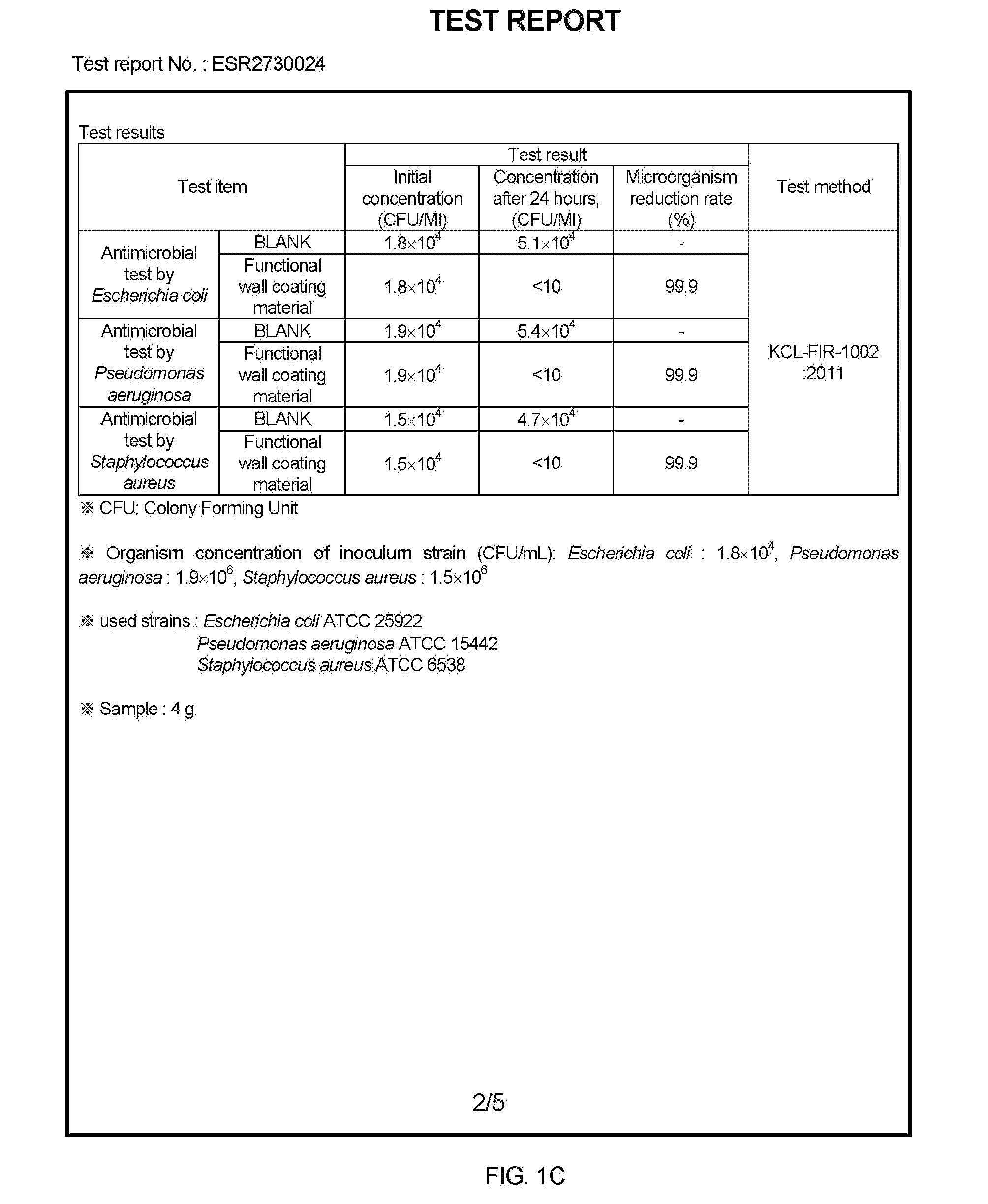Eco-friendly water-based paint composition for interior finishing materials of buildings
a water-based paint and composition technology, applied in the direction of biocides, coatings, paints, etc., can solve the problems of increasing the use of biocides, increasing the cost of building materials, and increasing the degradation phenomenon of cement itself, so as to improve the deodorization effect, improve the viscosity, and control the effect of workability
- Summary
- Abstract
- Description
- Claims
- Application Information
AI Technical Summary
Benefits of technology
Problems solved by technology
Method used
Image
Examples
example 1
Preparative Example 1
[0065]To 31 kg of an inorganic binder solution including 15 kg of an alkaline silicate solution and 16 kg of sulfuric acid, 45 kg of 300 mesh silica and 4 kg of 320 mesh diatomite were introduced. After adding 7 kg of water thereto, the solution was slowly agitated. Next, 10 kg of titanium dioxide and 1.1 kg of an antimicrobial agent in a microcapsule form were further introduced thereto, followed by slowly agitating, to yield 98.1 kg of a homogeneous water-based paint composition. The water-based paint composition was in a diluted mortar form.
example 2
Preparative Example 2
[0066]The same procedures as described in Preparative Example 1 were conducted except that 0.2 kg of a preservative was additionally introduced. The obtained water-based paint composition was also in a diluted mortar form.
Antimicrobial Activity Experiments 1 to 3
[0067]In order to identify antimicrobial activity of the water-based paint composition obtained in Preparative Example 1, Korea Conformity Laboratories (‘KCL’, which is established by the Korea construction, environment & merchandise testing institute, Gasan-dong 459-28, Geumcheon-gu, Seoul, Korea) was requested to execute an antimicrobial test. KCL selected Escherichia coli ATCC 25922, Pseudomonas aeruginosa ATCC 15442 and Staphylococcus aureus ATCC 6538, as test strains, and executed an antimicrobial test with these strains by its own test method (KCL-FIR-1002:2011).
[0068]It was demonstrated that these strains showed a decrease in bacteria of 99.9% or higher, compared to initial concentrations thereo...
experiment 1
Absorption Performance Experiment 1 of Volatile Organic Compounds
[0073]In order to identify an ability of purifying indoor air through absorption of volatile organic compounds contained in indoor air using the eco-friendly water-based paint composition obtained in Preparative Example 1, KCL was requested to execute an absorption test of volatile organic compounds, so as to determine performance for absorption of the volatile organic compounds. KCL adopted total volatile organic compounds (TVOC), toluene and formaldehyde, as test items, and executed an experiment for purification of indoor air in regard to the foregoing items according to guidelines for indoor air quality testing (Notification 2010-24 of the Ministry of Environment).
[0074]Results of the above experiment demonstrated that TVOC was 0.140 mg / (m2.h), toluene was not detected, and formaldehyde was only 0.002 mg / (m2.h).
[0075]FIG. 3A is a cover of a test report on purification performance of indoor air, and FIG. 3B illustra...
PUM
| Property | Measurement | Unit |
|---|---|---|
| wt. % | aaaaa | aaaaa |
| temperature | aaaaa | aaaaa |
| workability | aaaaa | aaaaa |
Abstract
Description
Claims
Application Information
 Login to View More
Login to View More - R&D
- Intellectual Property
- Life Sciences
- Materials
- Tech Scout
- Unparalleled Data Quality
- Higher Quality Content
- 60% Fewer Hallucinations
Browse by: Latest US Patents, China's latest patents, Technical Efficacy Thesaurus, Application Domain, Technology Topic, Popular Technical Reports.
© 2025 PatSnap. All rights reserved.Legal|Privacy policy|Modern Slavery Act Transparency Statement|Sitemap|About US| Contact US: help@patsnap.com



